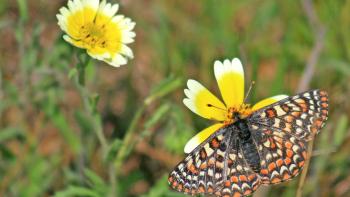Wildlife of the Ridge
Máyyan 'Ooyákma – Coyote Ridge Open Space Preserve is home to a diverse array of wildlife specialized to thrive in this unique landscape, many of which are endemic, or found nowhere else. The local vegetation and animal life feeds them, the watershed hydrates them, plant cover provides them with shelter and the uninterrupted open spaces support their larger habitat range as a whole.
So, which animals call this landscape home?

Bay checkerspot butterfly
These iconic critters are endemic to Máyyan 'Ooyákma – Coyote Ridge, meaning they live exclusively in this region and nowhere else. The highly specific niche of this butterfly makes protecting the habitat sustaining it critically important. This threatened species, with a wingspan of no more than two inches, depends on serpentine habitat for its survival. Its diet consists largely of the dwarf plantain which is also endemic to the ridge. With dwindling habitat and food supply, these butterflies are increasingly at risk

Tule elk
Once close to extinction, tule elk--also endemic to California--have made a remarkable recovery over the last hundred years. These creatures were hunted throughout the 1800s and their population was further decimated by habitat loss. Now, 5,100 tule elk are thought to live in California. Their range extends up and down the Diablo Mountain range, which finds its closest connection to the Santa Cruz Mountains at Máyyan 'Ooyákma – Coyote Ridge.

Golden eagle
These charismatic birds are found all over the South Bay. While they are migratory in many parts of the county, in this region these birds stick around all year long. They typically love grasslands and woodlands and have large nests in wooded areas, snacking on small mammals, reptiles and fish. If you’re lucky, you’ll spot their 6-8 foot wingspan soaring above you at altitudes of up to 16,000 feet.

Opler’s longhorn moth
A lesser known Máyyan 'Ooyákma resident is the Opler’s moth, a member of the “fairy moth” family. These small critters are dark and metallic, and the length of their forewings is less than a quarter of an inch. Endemic to serpentine grassland, these uniquely specialized moths eat cream cups, a white and yellow wildflower, in their larval stage – one of the many wildflowers that grow in this landscape every spring.
Mountain lion
Mountain lions are crepuscular, meaning they are most active during twilight hours, hunting prey animals like deer, elk, squirrels, and more. These cats depend on large swaths of habitat for their success surviving, and landscapes like Máyyan 'Ooyákma – Coyote Ridge, located at the point with the smallest distance between the Santa Cruz Mountains and the Diablo Range, increase critical connectivity, providing the large cats with the space they need to roam. Due to rapid development of the South Bay in the last few decades, their range is dramatically less than what it once was, and protecting their habitat is more important than ever.

American badger
Badgers are nocturnal, solitary and spend much of their time underground. While unlikely, you may spot their brown bodies with a white-striped head when traversing throughout the preserve. As general carnivores, badgers will eat rats, squirrels, mice, insects or birds, controlling populations and supporting ecosystem health. They are also known to hunt with coyotes, using their combined speed and digging ability to catch prairie dogs and other small mammals with ease.

Bobcat
Bobcats can be spotted throughout the Santa Clara Valley. These cats are abundant in North America and specifically in the Santa Clara Valley, dependent on landscapes like Coyote Valley and Máyyan 'Ooyákma to get from point A to point B. Learn more about their habitat ranges here. These cats are entirely carnivorous and like to prey on smaller mammals such as rabbits, mice, moles and squirrels, which brings us to our final animal...

Ground squirrel
Ground squirrels can be found all over North America. You’ll likely spot species like the Western gray squirrel, Eastern gray squirrel and the fox squirrel traversing the preserve’s hillsides and burrows. As autumn approaches, these critters, rather than hibernating, will begin storing acorns to feed sustain themselves over winter. Squirrels also play a valuable role in their ecosystem by acting as prey for predators like bobcats, mountain lions and snakes.
Máyyan 'Ooyákma – Coyote Ridge supports a rich ecosystem, and the wildlife living in it serve critical roles balancing the food chain and promoting biodiversity. To protect the unique species including those listed above, the preserve experience at Máyyan 'Ooyákma - Coyote Ridge will be unlike any other.



